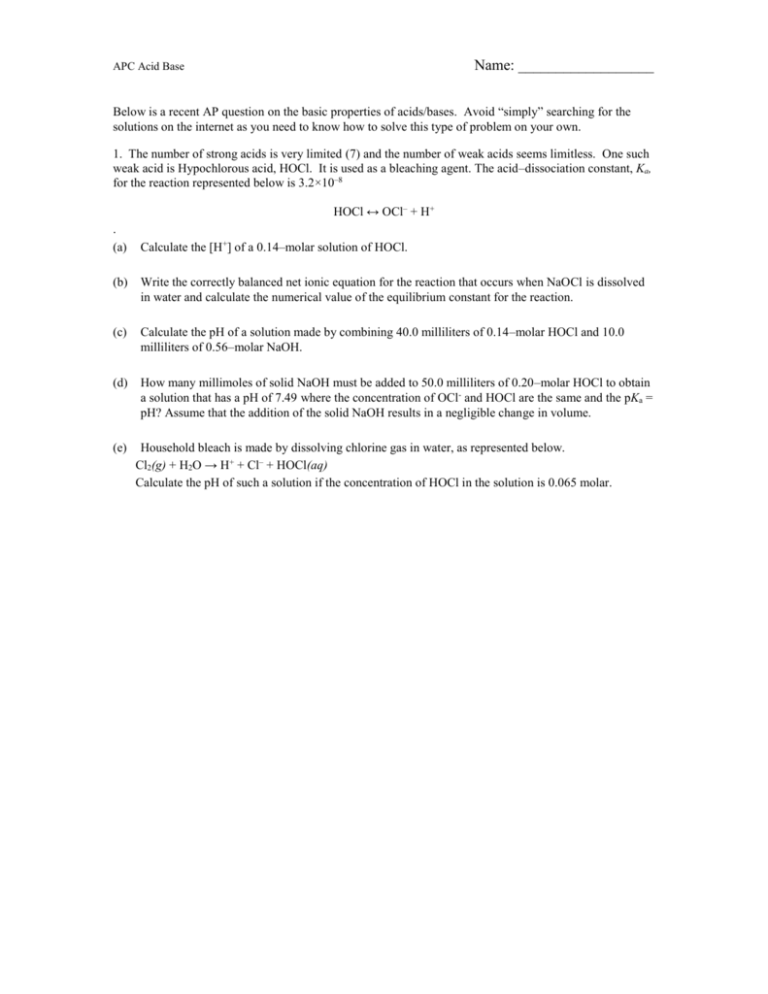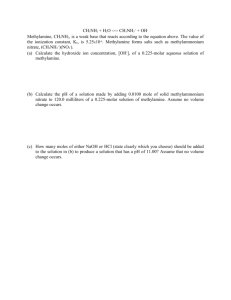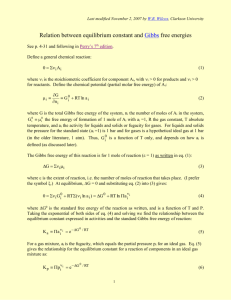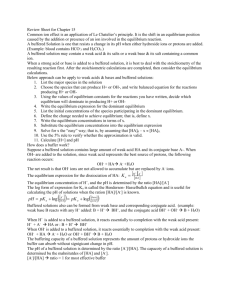APC AP Problems for Acid Base Equilibrium Le - Parkway C-2
advertisement

Name: __________________ APC Acid Base Below is a recent AP question on the basic properties of acids/bases. Avoid “simply” searching for the solutions on the internet as you need to know how to solve this type of problem on your own. 1. The number of strong acids is very limited (7) and the number of weak acids seems limitless. One such weak acid is Hypochlorous acid, HOCl. It is used as a bleaching agent. The acid–dissociation constant, Ka, for the reaction represented below is 3.2×10–8 HOCl ↔ OCl– + H+ . (a) Calculate the [H+] of a 0.14–molar solution of HOCl. (b) Write the correctly balanced net ionic equation for the reaction that occurs when NaOCl is dissolved in water and calculate the numerical value of the equilibrium constant for the reaction. (c) Calculate the pH of a solution made by combining 40.0 milliliters of 0.14–molar HOCl and 10.0 milliliters of 0.56–molar NaOH. (d) How many millimoles of solid NaOH must be added to 50.0 milliliters of 0.20–molar HOCl to obtain a solution that has a pH of 7.49 where the concentration of OCl- and HOCl are the same and the pKa = pH? Assume that the addition of the solid NaOH results in a negligible change in volume. (e) Household bleach is made by dissolving chlorine gas in water, as represented below. Cl2(g) + H2O → H+ + Cl– + HOCl(aq) Calculate the pH of such a solution if the concentration of HOCl in the solution is 0.065 molar. APC Equilibrium Name: __________________ Below is a recent AP question on equilibrium. Avoid “simply” searching for the solutions on the internet as you need to know how to solve this type of problem on your own. 1. Consider the following reaction of solid carbon and gaseous carbon dioxide. C(s) + CO2 (g) 2 CO(g) At 1,160 K, the reactants were placed in a rigid 2.00 L container, and the reaction shown above occurred. As the reaction proceeded, the total pressure in the container was monitored. When equilibrium was reached, there was still some C(s) remaining in the container. Results are recorded in the table below. Time (hours) Total Pressure of Gases in Container at 1,160 K (atm) 0.0 5.00 2.0 6.26 4.0 7.09 6.0 7.75 8.0 8.37 10.0 8.37 (a) Write the expression for the equilibrium constant, Kp for the reaction. (b) Calculate the number of moles of CO2(g) initially placed in the container. (Assume that the volume of the solid carbon is negligible.) (c) For the reaction mixture at equilibrium at 1,160 K, the partial pressure of the CO2(g) is 1.63 atm. Calculate (i) the partial pressure of CO(g), and (ii) the value of the equilibrium constant, Kp (d) If a suitable solid catalyst were placed in the reaction vessel, would the final total pressure of the gases at equilibrium be greater than, less than, or equal to the final total pressure of the gases at equilibrium without the catalyst? Justify your answer. (Assume that the volume of the solid catalyst is negligible.) In another experiment involving the same reaction, a rigid 2.00 L container initially contains 10.0 g of C(s), plus CO(g) and CO2(g), each at a partial pressure of 2.00 atm at 1,160 K. (e) Predict whether the partial pressure of CO2(g) will increase, decrease, or remain the same as this system approaches equilibrium. Justify your prediction with a calculation. APC Le Chatelier’s Principle Name: __________________ Below is a recent AP question on Le Chatelier’s Principle. Avoid “simply” searching for the solutions on the internet as you need to know how to solve this type of problem on your own. C(s) + H2O(g) CO(g) + H2(g) Hº = +131kJ A rigid container holds a mixture of graphite pellets (C(s)), H2O(g), CO(g), and H2(g) at equilibrium. State whether the number of moles of CO(g) in the container will increase, decrease, or remain the same after each of the following disturbances is applied to the original mixture. For each case, assume that all other variables remain constant except for the given disturbance. Explain each answer with a short statement. (a) Additional H2(g) is added to the equilibrium mixture at constant volume. (b) The temperature of the equilibrium mixture is increased at constant volume. (c) The volume of the container is decreased at constant temperature. (d) The graphite pellets are pulverized.










